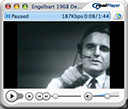Hoe oud is de hyperlink?

Iedere Nederlander weet dat de techno house in 1956 is uitgevonden. Maar uit welk jaar stamt de hyperlink eigenlijk? En de wordprocessor, de muis en de zoekmachine?
 Op de website van de Stanford University vind je een hele mik filmpjes waarin wetenschappers uitleggen – en tonen – hoe hyperlinks, wordprocessors, zoekmachines en nog veel meer ‘moderne’ dingen werken. En ze maken daarbij druk gebruik van picture-in-picture projectieschermen, videotelefoons en internetverbindingen.
Op de website van de Stanford University vind je een hele mik filmpjes waarin wetenschappers uitleggen – en tonen – hoe hyperlinks, wordprocessors, zoekmachines en nog veel meer ‘moderne’ dingen werken. En ze maken daarbij druk gebruik van picture-in-picture projectieschermen, videotelefoons en internetverbindingen.
En nu de grote vraag: uit welk jaar stammen die filmpjes? 1968!
Wat een held die Scott…kippenvel.
Via bovenstaande link van Stanford University:
On December 9, 1968, Douglas C. Engelbart and the group of 17 researchers working with him in the Augmentation Research Center at Stanford Research Institute in Menlo Park, CA, presented a 90-minute live public demonstration of the online system, NLS, they had been working on since 1962. The public presentation was a session in the of the Fall Joint Computer Conference held at the Convention Center in San Francisco, and it was attended by about 1,000 computer professionals. This was the public debut of the computer mouse.
Ik heb vannacht trouwens gelijk maar een CD-tje van Raymond Scott besteld want als artiest in de electronische muziek moet je toch de pioniers in huis hebben vind ik.
@Bertrand: Ook ík dacht altijd dat al dat moois uit de PARC Xerox laboratoria kwam. Maar die filmpjes waar ik in mijn posting naar verwijs tonen toch echt aan dat die lui aan het Stanford Research Institute er al sinds 1962 aan werkten…
@Rene: Die Raymond Scott verslaat inderdaad ‘ons eigen’ NatLab. Toch wel jammer, eigenlijk 😉
In de omschrijving van dat boek dat Paul noemt lees ik dat er een directe link bestaat tussen deze jaren ’60 pioniers en het PARC Xerox lab:
“Central to ‘Dormouse’ is the story of Doug Engelbart, the ’tragic hero’ of computing, and the man who invented — and demonstrated — virtually every aspect of modern computing as much as a decade before the PC. Engelbart presided over the ground-breaking 1968 demo of his Augment concept, which included multiple overlapping windows, the original mouse, a screen cursor, video conferencing, hyperlinks and cut-and-paste — virtually every aspect of the modern PC user interface three decades later. Yet the combination of Engelbart’s ego and his poor management skills doomed the project, and his best team members leaked over to Xerox PARC, where they worked on the equally doomed ‘Alto’ workstation, source of Steve Job’s inspiration.”
Erg grappig is ook dat de ontwikkeling van al dat moois wordt toegewezen aan de combinatie van Open Source programming en het trippen op LSD. (Waarvan het laatste inmiddels verboden is, en het eerste door monopolisten wordt bevochten).
Gerelateerde artikelen
Marketingfacts. Elke dag vers. Mis niks!
Marketingfacts. Elke dag vers. Mis niks!